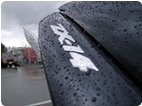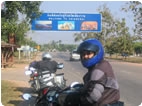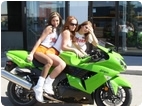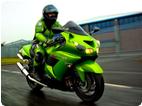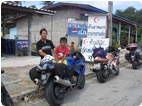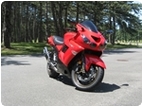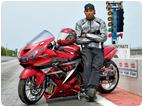Fellas,
An oldie but goodie. A great article for street riders who like to twist it up and keep it on two.
THE PACE
BY NICK IENATSCH
.... Racing involves speed, concentration and commitment; the results of a mistake are usually catastrophic because there's little room for error riding at 100 percent. Performance street riding is less intense and further from the absolute limit, but because circumstances are less controlled, mistakes and over aggressiveness can be equally catastrophic. Plenty of roadracers have sworn off street riding. "Too dangerous, too many variables and too easy to get carried away with too much speed," track specialists claim. Adrenaline-addled racers find themselves treating the street like the track, and not surprisingly, they get burned by the police, the laws of physics and the cold, harsh realities of an environment not groomed for ten-tenths riding.
.... But as many of us know, a swift ride down a favorite road may be the finest way to spend a few free hours with a bike we love. And these few hours are best enjoyed riding at The Pace.
.... A year after I joined Motorcyclist staff in 1984, Mitch Boehm was hired. Six months later, The Pace came into being, and we perfected it during the next few months of road testing and weekend fun rides. Now The Pace is part of my life - and a part of the Sunday morning riding group I frequent. The Pace is a street riding technique that not only keeps street riders alive, but thoroughly entertained as well.
THE PACE
.... The Pace focuses on bike control and de-emphasizes outright speed. Full-throttle acceleration and last minute braking aren't part of the program, effectively eliminating the two most common single-bike accident scenarios in sport riding. Cornering momentum is the name of the game, stressing strong, forceful inputs at the handlebar to place the bike correctly at the entrance of the turn and get it flicked in with little wasted time and distance. Since the throttle wasn't slammed open at the exit of the last corner, the next corner doesn't require much, if any, braking. It isn't uncommon to ride with our group and not see a brake light flash all morning.
.... If the brakes are required, the front lever gets squeezed smoothly, quickly and with a good deal of force to set entrance speed in minimum time. Running in on the brakes is tantamount to running off the road, a confession that you're pushing too hard and not getting your entrance speed set early enough because you stayed on the gas too long. Running The Pace decreases your reliance on the throttle and brakes, the two easiest controls to abuse, and hones your ability to judge cornering speed, which is the most thrilling aspect of performance street riding.
YOUR LANE IS YOUR LIMIT
.... Crossing the centerline at any time except during a passing maneuver is intolerable, another sign that you're pushing too hard to keep up. Even when you have a clean line of sight through a left-hand kink, stay to the right of the centerline. Staying on the right side of the centerline is much more challenging than simply straightening every slight corner, and when the whole group is committed to this intelligent practice, the temptation to cheat is eliminated through peer pressure and logic. Though street riding shouldn't be described in racing terms, you can think of your lane as the race track. Leaving your lane is tantamount to a crash.
.... Exact bike control has you using every inch of your lane if the circumstances permit it. In corners with a clear line of sight and no oncoming traffic, enter at the far outside of the corner, turn the bike relatively late in the corner to get a late apex at the far inside of your lane and accelerate out, just brushing the far outside of your lane as your bike stands up. Steer your bike forcefully but smoothly to minimize the transition time. Don't hammer it down because the chassis will bobble slightly as it settles, possibly carrying you off line. Since you haven't charged in on the brakes, you can get the throttle on early, before the apex, which balances and settles your bike for the drive out.
.... More often than not, circumstances do not permit the full use of your lane from yellow line to white line and back again. Blind corners, oncoming traffic and gravel on the road are a few criteria that dictate a more conservative approach, so leave yourself a three or four foot margin for error, especially at the left side of the lane where errant oncoming traffic could prove fatal. Simply narrow your entrance on a blind right-harder and move your apex into your lane three feet on blind left turns in order to stay free of unseen oncoming traffic hogging the centerline. Because you're running at The Pace and not flat out, your controlled entrances offer additional time to deal with unexpected gravel or other debris in your lane; the outside wheel track is usually the cleanest through a dirty corner since a car weights its outside tires most, scrubbing more dirt off the pavement in the process, so aim for that line.
A GOOD LEADER, WILLING FOLLOWERS
.... The street is not a racing environment, and it takes humility, self assurance and self control to keep it that way. The leader sets the pace and monitors his mirrors for signs of raggedness in the ranks that follow, such as tucking in on straights, crossing over the yellow line and hanging off the motorcycle in the corners, If the leader pulls away, he simply slows his straight way speed slightly but continues to enjoy the corners, thus closing the ranks but missing none of the fun. The small group of three or four riders I ride with is so harmonious that the pace is identical no matter who's leading. The lead shifts occasionally with a quick hand sign, but there's never a pass for the lead with an ego on the sleeve. Make no mistake, the riding is spirited and quick in the corners. Anyone with a right arm can hammer down the straights; it's proficiency in the corners that makes The Pace come alive.
.... Following distances are relatively lengthy, with the straightaways taken at more moderate speeds, providing the perfect opportunity to adjust the gaps. Keeping a good distance serves several purposes, besides being safer. Rock chips are minimized, and the police or highway patrol won't suspect a race is in progress. The Pace's style of not hanging off in corners also reduces the appearance of pushing too hard and adds a degree of maturity and sensibility in the eyes of the public and the law. There's a definite challenge to cornering quickly while sitting sedately on your bike.
.... New rider indoctrination takes some time because The Pace develops very high cornering speeds and newcomers want to hammer the throttle on the exits to make up for what they lose at the entrances. Our group slows drastically when a new rider joins the ranks because our technique of moderate straightaway speed and no brakes can suck the unaware into a corner too fast, creating the most common single bike accident. With a new rider learning The Pace behind you, tap your brake lightly well before the turn to alert him and make sure he understands there's no pressure to stay with the group.
.... There's plenty of ongoing communication during The Pace. A foot off the peg indicates debris in the road, and all slowing or turning intentions are signaled in advance with the left hand and arm. Turn signals are used for direction changes and passing, with a wave of the left hand to thank the cars that move right and make it easy for motorcyclists to get past. Since you don't have a death grip on the handlebar, your left hand is also free to wave to oncoming riders, a fading courtesy that we'd like to see return. If you're getting the idea The Pace is a relaxing, noncompetitive way to ride with a group, you are right.
RELAX AND FLICK IT
.... I'd rather spend a Sunday in the mountains riding at The Pace than a Sunday at the racetrack, it's that enjoyable. Countersteering is the name of the game; smooth, forceful steering input at the handlebar relayed to the tires' contact patches through a rigid sport bike frame. Riding at The Pace is certainly what bike manufacturers had in mind when sport bikes evolved to the street.
.... But the machine isn't the most important aspect of running The Pace because you can do it on anything capable of getting through a corner. Attitude is The Pace's most important aspect: realizing the friend ahead of you isn't a competitor, respecting his right to lead the group occasionally and giving him credit for his riding skills. You must have the maturity to limit your straightaway speeds to allow the group to stay in touch and the sense to realize that racetrack tactics such as late braking and full throttle runs to redline will alienate the public and police and possibly introduce you to the unforgiving laws of gravity. When the group arrives at the destination after running The Pace, no one feels outgunned or is left with the feeling he must prove himself on the return run. If you've got some thing to prove, get on a racetrack.
.... The racetrack measures your speed with a stop watch and direct competition, welcoming your aggression and gritty resolve to be the best. Performance street riding's only yardstick is the amount of enjoyment gained, not lap times, finishing position or competitors beaten. The differences are huge but not always remembered by riders who haven't discovered The Pace's cornering pureness and group involvement. Hammer on the racetrack. Pace yourself on the street.
© Copyright MOTORCYCLIST Magazine
November 1991 issue
2012 Black ZX-14R - 2Bros Black Series slips with P1Xs, Puig screen, Helibar risers, Targa fender eliminator, Tech Spec tank pads, T-Rex spools, RADS on rims
2012 Black ZX-14R - Two Brothers Black Series slips, Targa fender eliminator, T-Rex spool -- TOTALED!
2006 GSXR 600 (track bike only) - Jardine slip, BMC filter, Armour Bodies skins
2007 Plasma Blue ZX-14 - Gone but not forgotten
2002 GSXR 1000 - Long gone
2001 CBR F4i - Long gone
